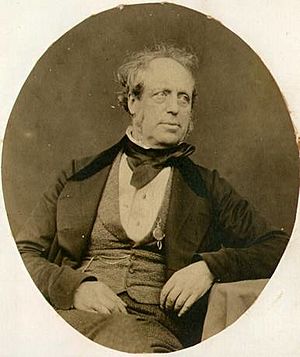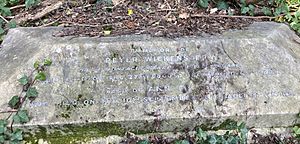Peter Wickens Fry facts for kids
Quick facts for kids
Peter Wickens Fry
|
|
|---|---|

Peter Wickens Fry
|
|
| Born |
Peter Wickens Fry
1795 Compton Bishop, Somerset, Kingdom of Great Britain
|
| Died | 29 August 1860 (aged 64–65) |
| Nationality | English |
| Occupation | Photographer and solicitor |
| Years active | 1841–60 The photo is from the personal album of Jane Martha St. John. |
Peter Wickens Fry (1795 – 27 August 1860) was an early English photographer. Even though he worked as a lawyer in London, he loved photography and helped it grow. In the early 1850s, Fry worked with Frederick Scott Archer on new ways to take pictures using a method called the wet collodion process. He also helped Roger Fenton start the Royal Photographic Society in 1853. You can see some of his photographs at the Victoria and Albert Museum in London.
Contents
Early Life and Family Background
Peter Wickens Fry was born in 1795 in a village called Compton Bishop in Somerset, England. His parents were Peter Fry and Joanna Chapman. He had two younger brothers and two sisters.
His brother Bruges later lived in Cheddar. Peter himself lived in Compton House in Compton Bishop. He trained to be a solicitor, which is a type of lawyer. He started his career in law but later became one of the first people to explore photography in England.
A Pioneer in Photography
In the early 1840s, Peter Fry became very interested in photography. This was a brand new art form at the time. He experimented with early photography methods even before Henry Fox Talbot created the calotype process in 1841.
Early Photography Experiments
Fry first tried making portraits using a method called daguerreotype. His passion and progress in photography led him to be chosen for the Society of Arts (RSA) in 1845. This was a big honor for him.
The Calotype Club
Peter Fry started a group called the Calotype Club at his home. The first meeting was in 1847. It was a casual gathering of 12 photographers who were interested in the calotype process. They met once or twice a month to talk about new ideas and ways to use photography. In 1848, the club changed its name to the Royal Photographic Club.
Other members of the club included Robert Hunt, who was an expert on early photography. Frederick Scott Archer, a sculptor, and Dr. Hugh Welch Diamond, who was a doctor at a mental health hospital, were also members.
Developing New Photography Methods
In the early 1850s, Fry worked closely with Frederick Scott Archer. They experimented with the wet collodion process. This was a new way to create photographic negatives. The Photographic Journal reported that Fry did a lot to help this new method become popular.
Fry showed his first picture made with the collodion process at a Society of Arts meeting in 1851. He also introduced Archer to Richard Horne. Horne's display at The Great Exhibition in 1851 might have shown the first collodion picture to the public.
In 1852, Fry and Archer worked together on the collodion positive process, also known as ambrotype. This method was great for taking portraits. It was an improved version of the wet collodion process. It made pictures look like they had a velvet lining.
Exhibitions and Societies
In the winter of 1852–53, Fry and the Society held their first exhibition of photographs. Peter Fry was very active in helping Roger Fenton create the Royal Photographic Society in 1853. This society became very important for photographers.
He was a member of the Royal Photographic Society's Council. He had to leave his position when he became ill, shortly before he passed away.
Legal Career and Legacy
Besides photography, Peter Fry had a successful legal career. He worked as a solicitor in London. He even became a London Commissioner, which meant he could administer oaths in court. He also served as a Director for a life insurance company.
Towards the end of his life, he was the lawyer for James Henderson in a famous court case. This case was about Henry Fox Talbot claiming his calotype patent rights were broken. Fry successfully won the case for his client.
Peter Wickens Fry passed away on August 27, 1860, in London. He is buried in a family tomb at Highgate Cemetery. Many of his photographs are now kept at the Victoria and Albert Museum in London.


